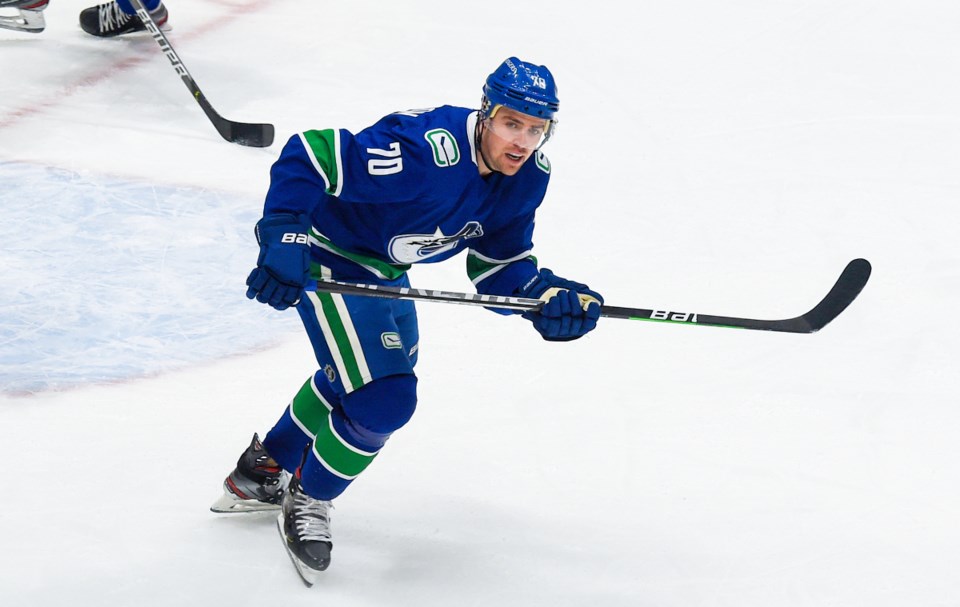Tanner Pearson has been a solid second-line forward for the Â鶹´«Ă˝Ół»Canucks over the past two seasons and change. Lined up on Bo Horvat’s left side, Pearson has faced tough competition night after night and put up 76 points in a total of 138 games for the Canucks in the regular season and playoffs.
To go with his on-ice performance, Pearson is well-liked in the Canucks’ locker room and has Stanley Cup-winning experience from his time with the Los Angeles Kings.
“Tanner is an important player in our group. I think since we traded for him, him and Bo have been real good together,” said Canucks GM Jim Benning a month ago. “He's a real pro, like, he leads by example, he plays the right way, he's strong on the walls, he gets to the front of the net. But the way he handles himself on a day-to-day basis is a guy that we want our younger players around. He's won a Stanley Cup, I think he helps with our culture in our room and in our group.”
All of those help explain why Benning re-signed Pearson to a three-year deal with an average annual value of $3.25 million. None of those things, however, help his new contract make any sort of sense for the Canucks.
Pearson’s past performance isn’t the issue, even if he only has 6 goals in 33 games this season while playing prime minutes in the top-six and on the power play. The issues are manyfold: how will Pearson perform in the future, how does his new contract fit in the Canucks’ salary cap picture, and why was his contract a priority ahead of all-important second contracts for stars Elias Pettersson and Quinn Hughes?
A return of the Sea of Granlunds
Unfortunately, Pearson’s new contract bears a striking resemblance to past mistakes by Benning.
There’s the three-year deal he gave Sam Gagner worth $3.15 million per year. After just one year, Benning buried Gagner in the minors. Then there’s Sven Baertschi, given a three-year deal worth $3.37 million per year after finding a home on the Canucks’ second line. A year later, Baertschi was buried in the minors too.
That’s not to say that Pearson will face the same fate as Gagner and Baertschi. The Canucks have a couple of other examples of forwards signed to multi-year deals worth around $3 million per year that have managed to stay in the lineup, even when they haven’t performed up to their cap hit: Jay Beagle and Antoine Roussel.
The late Jason Botchford referred to the Canucks' obsession with bland middle-six forwards as the "Sea of Granlunds." Perhaps we'll need to refer to this in the future as the Profusion of Pearsons.
The Canucks have some bad contracts coming off the books after this season and the next, including those belonging to Beagle and Roussel, but it doesn’t matter if bad contracts expire when you keep signing new bad contracts.
The truth is that Pearson is unlikely to be a second-line calibre forward during his three-year contract. His play has declined over the past few seasons and he will be 29 before the start of his contract. From , players typically decline in their late 20’s and get steadily worse after the age of 30.
On a good team, Pearson is likely a third-line forward as of this season and he’s likely to get worse in the coming years.
Chipping away at what little cap space remains
Even more troubling is the cap space that Pearson takes up, particularly since the Canucks still need to re-sign Pettersson and Hughes. With Thatcher Demko already re-signed at $5 million per year, the cap space gets even tighter.
The issue isn’t re-signing Pettersson and Hughes — obviously, that will get done. The issue is how much cap space will the Canucks have left to upgrade in other areas to improve for the future.
The Canucks have just two NHL defencemen signed for next season, as well as Hughes when he gets his new contract. Defence is the area where the Canucks need the most improvement. Where will that improvement come from when they have no cap space to work with?
Re-signing Pearson also takes one of the Canucks’ only trade chips off the board. Especially with the rest of the team dealing with a COVID-19 outbreak, Pearson was one of the few players that could potentially be traded, even if he is coming off an injury. In a season where it seemed clear the Canucks were not going to make the playoffs over a month ago, they’re missing out on a chance to improve for the future at the expense of re-signing a player that never should have been a priority.
Pearson even received a no-trade clause in the first year of his new contract, adding to the Canucks’ league-leading number of such clauses. According to The Athletic’s Thomas Drance, he has a modified no-trade clause in the second year of the contract. If the deal is backloaded as Drance indicates and Pearson’s play drops off as predicted, he won’t need any trade protection in the third year — the contract itself will be the no-trade clause.
At a time when the Canucks needed to be ultra-efficient with their contracts, Pearson’s new deal just doesn’t add up.




